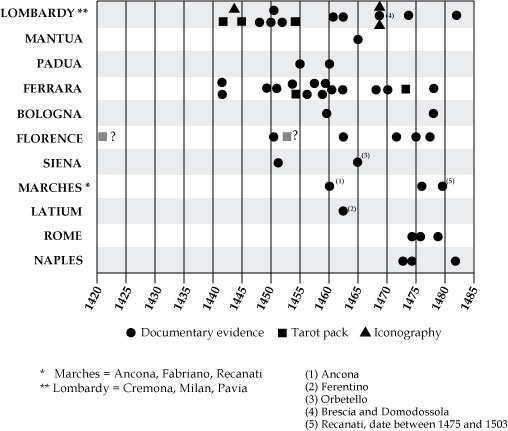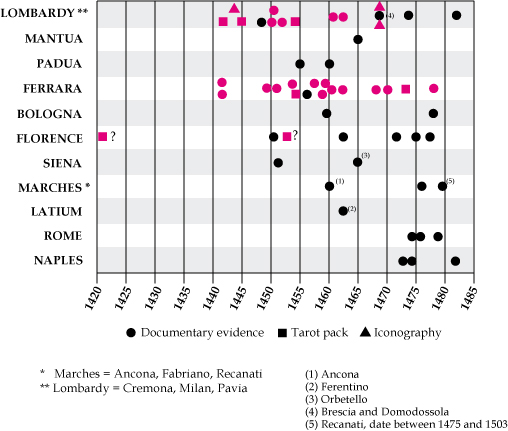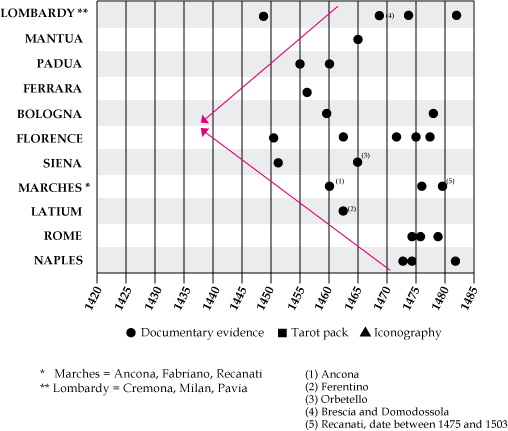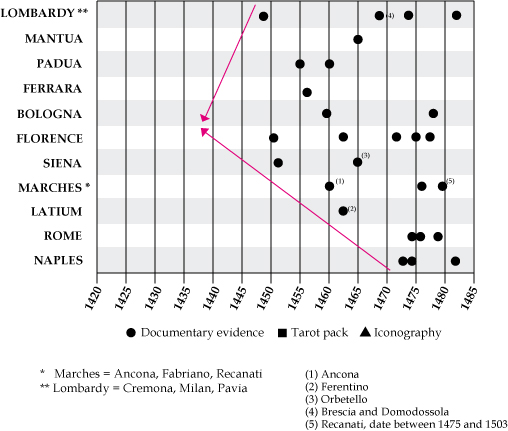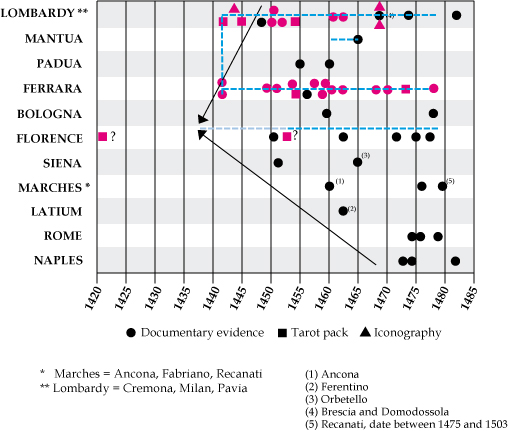Ross G. R. Caldwell wrote:But I don't think Visconti invented the game - it would not explain the cheaper cards existing so soon. You have to push the date of invention further back than I think deductions from the pattern of the evidence allows.
These issues were discussed on this thread -
viewtopic.php?f=11&t=258&hilit=chart&start=30
and here -
viewtopic.php?f=12&t=334&hilit=chart&start=120#p5523
(start there)
But we can go further if you like. Here is all of the evidence for triumph cards - physical cards, documentary mentions, and plausible iconography (like Palazzo Borromeo) - from 1442 to 1482.
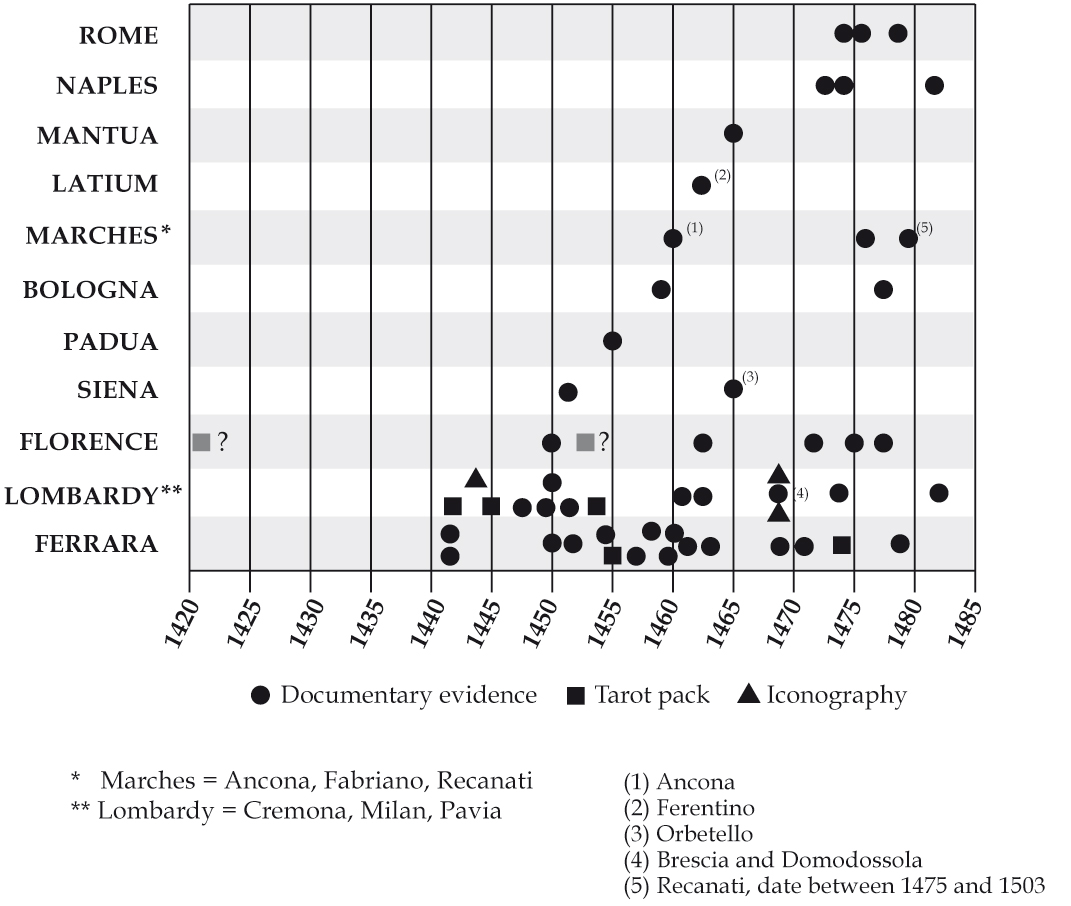
This chart is arranged strictly chronologically, as far as it can be ascertained in some cases (like specific surviving packs). But, except for the differences between documentation of "triumph cards", and surviving artifacts, it is not qualified any further (the two "?" squares refer to Cristina Fiorini's controversial theory placing the Rothschild cards around 1420 in Florence - it is repeated to show another view of the date of these cards).
The main thing I learned from it is that, taken as a whole, the spread of the evidence leaves no more than 5 years' gap - maybe less than three years - between one documentation and the next. Not in any one place, necessarily, but overall. I reasoned that since the two decades before 1442 are no less well documented than the two decades afterward - there is no "black hole" of information all over Italy between 1420 and 1440 - then
some evidence should turn up
somewhere, just as historical accident makes it turn up in the years after 1442 with such regularity.
Since it does not, it follows that Triumph cards had to be invented sometime not too long before 1442 - short enough to fall into an acceptable margin of error derived from what we
do know. As I noted, that margin of error, or silence, is 3-5 years in the attested evidence. So I concluded that the game of Triumphs should have been invented 3-5 years before 1442 (or 1437-1441 inclusive).
But the chart isn't qualified by any other criteria - type of cards, precise form of the documentation, geographic proximity, etc. Chronology can be a helpful way to arrange data, but it is not the only way.
So, we can put the chart on geographic scale instead, from the most southerly evidence (Naples) to the most northerly and westerly (Milan) -
This chart makes clear some points I tried to make in writing in my earliest post on the subject. The game appears simultaneously - as far as historical accuracy will allow - in Ferrara and Milan. Of course there is a perfectly clear historical scenario for this - the two cities were extremely close in 1440-1441.
But the chart also brings up something else - what else do Ferrara and Milan have in common? They were both aristocratic courts, and bulk of their surviving evidence concerns luxury
trionfi cards. By contrast, the rest of the references on the chart are documentary references referring to viewings of the game or permissions for playing it - i.e. referring to a more common level of pack and game. We may call this "popular", so long as we remember that popular doesn't mean "dirt cheap" or "low", but just to distinguish it from "luxury" and "courtly".
So the chart essentially visually shows the separation of the cream from the milk, or the oil from the water, if you like.
If we distinguish the "cream" from the "milk", we get a chart like this (one Ferrara 1442 reference should be black - don't know why I forgot that) -
If we skim off the cream and leave only milk, we get this (again remembering the 1442 reference) -
The arrows show a propsed pattern of diffusion for the popular game, with the Lombary reference (Marcello's 1448 gifted pack) having an unknown provenance.
This chart shows Marcello's gift as part of the diffusion (diffusion meaning the game was known and played in a place, not just that someone mentioned it) -
Either scenario is plausible. The reason the arrows point to Bologna-Florence is drawing backwards across the pattern of the data to a plausible place of origin - it has to be before 1442 because we know Tarot existed by then, and the earliest hint of a popular product, Marchione Burdochio, is 1442. So it points to the axis of Bologna-Florence, and the A type sequence and iconography.
If we put all of the evidence back together, cream on top of milk -
we have a plausible theory of transmission and development of the two kinds of
trionfi, popular and luxury. The game of Triumphs was invented in the lat 1430s in either Bologna or Florence, among the intelligentsia who acted as courtiers and other functions in the courtly world, and the courts of Ferrara and Milan quickly took it up. They made luxurious versions according to their taste - the blue dotted lines show the straight pattern in these two courts. Mantua's reference says the physician had a pack "gilded in the Florentine manner", which means his pack was also luxurious (and incidentally shows the audience for Florentine cards like the Charles VI were not necessarily nobility or "first citizens" like the Medici).
The pattern of diffusion of the popular game is more spotty, as is to be expected, but it remains clear that the pattern points towards the Bologna-Florence axis, A-type, southern type.



